In the age of fast, interactive, and seamless user experiences, having your website reload every time the user takes an action can feel outdated and clunky. Fortunately, combining PHP with AJAX (Asynchronous JavaScript and XML) allows developers to build dynamic websites where content updates in real time—without the need for full page refreshes.
In this blog, we’ll explore how PHP and AJAX work together to deliver smoother user interactions, and we’ll walk through a practical example of loading data dynamically.
Why Use AJAX with PHP?
Traditionally, every time a user submitted a form or clicked a button that required new data, the browser would send a request to the server and reload the entire page with the new content. This is not only inefficient but also negatively impacts user experience.
AJAX changes that by allowing parts of a web page to update without reloading the whole page. Here’s what it offers:
- Improved user experience: Content updates seamlessly, often appearing faster.
- Reduced server load: Only specific data is exchanged instead of re-rendering entire pages.
- Smoother UI: Users stay on the same page, making interactions feel more fluid.
How It Works: The Basic Flow
- User interaction: The user clicks a button or makes a selection.
- JavaScript triggers AJAX: A JavaScript function sends a request to a PHP script on the server.
- PHP processes the request: The PHP script fetches or processes data.
- AJAX receives the response: JavaScript updates the DOM based on the response—without refreshing the page.
Practical Example: Load User Info with AJAX and PHP
Let’s build a small example where clicking a button loads user data from the server.
1. HTML (index.html)
<!DOCTYPE html>
<html lang="en">
<head>
<meta charset="UTF-8">
<title>AJAX with PHP</title>
</head>
<body>
<h2>User Information</h2>
<button onclick="loadUser()">Load User</button>
<div id="user-info"></div>
<script>
function loadUser() {
const xhr = new XMLHttpRequest();
xhr.open("GET", "get_user.php", true);
xhr.onload = function() {
if (xhr.status === 200) {
document.getElementById("user-info").innerHTML = xhr.responseText;
}
};
xhr.send();
}
</script>
</body>
</html>
2. PHP (get_user.php)
<?php
// Simulate database data
$user = [
"name" => "John Doe",
"email" => "john@example.com",
"location" => "New York"
];
echo "<ul>";
echo "<li><strong>Name:</strong> " . $user['name'] . "</li>";
echo "<li><strong>Email:</strong> " . $user['email'] . "</li>";
echo "<li><strong>Location:</strong> " . $user['location'] . "</li>";
echo "</ul>";
?>
What Happens Here:
- When the button is clicked, JavaScript makes an asynchronous request to
get_user.php. - PHP returns user data (simulated here as an array).
- The browser inserts the returned HTML into the page without a refresh.
Tips for Using AJAX & PHP Effectively
- Validate data server-side: Even though AJAX sends requests quietly, always validate and sanitize inputs on the PHP side.
- Use JSON for complex data: If you're sending or receiving structured data, JSON is a great format to work with.
- Handle errors gracefully: Always check for HTTP status codes and provide fallback content if the request fails.
- Use libraries if needed: jQuery simplifies AJAX syntax if you prefer shorter code.
Final Thoughts
Integrating AJAX with PHP is a powerful way to create modern, interactive web applications. Whether you're building a form that submits without reloading, a chat interface, or a live search feature, this duo allows you to create smooth, real-time experiences that users expect from today’s web.
Mastering dynamic content loading is not just about making things "cool"—it's about enhancing usability, performance, and engagement. So start experimenting with AJAX and PHP, and bring your web pages to life without the blink of a page reload!
Frequently Asked Questions (FAQ)
What is AJAX in PHP?
AJAX (Asynchronous JavaScript and XML) is a technique that allows parts of a web page to update without reloading the entire page. When combined with PHP, it enables seamless data exchange between the client and server.
Why should I use AJAX with PHP?
Using AJAX with PHP allows for smoother, faster interactions by updating content dynamically, reducing page reloads, and enhancing user experience.
Can AJAX be used with PHP to submit forms?
Yes, AJAX can be used to submit forms to a PHP script without reloading the page. This allows for real-time validation and better user feedback.
Do I need to use jQuery for AJAX in PHP?
No. While jQuery simplifies AJAX, you can also use native JavaScript methods like XMLHttpRequest or fetch() to make AJAX requests.
Is PHP still relevant with modern JavaScript frameworks?
Yes, PHP remains widely used for server-side development, especially in CMS platforms like WordPress. It integrates well with front-end frameworks via AJAX.
What kind of data can PHP return in an AJAX call?
PHP can return data in various formats such as plain text, HTML, JSON, or XML. JSON is commonly used for its simplicity and compatibility with JavaScript.
How do I handle errors in AJAX with PHP?
Implement error handling using HTTP status codes and proper server responses. Use JavaScript to detect errors via xhr.status or catch blocks for fetch().
















